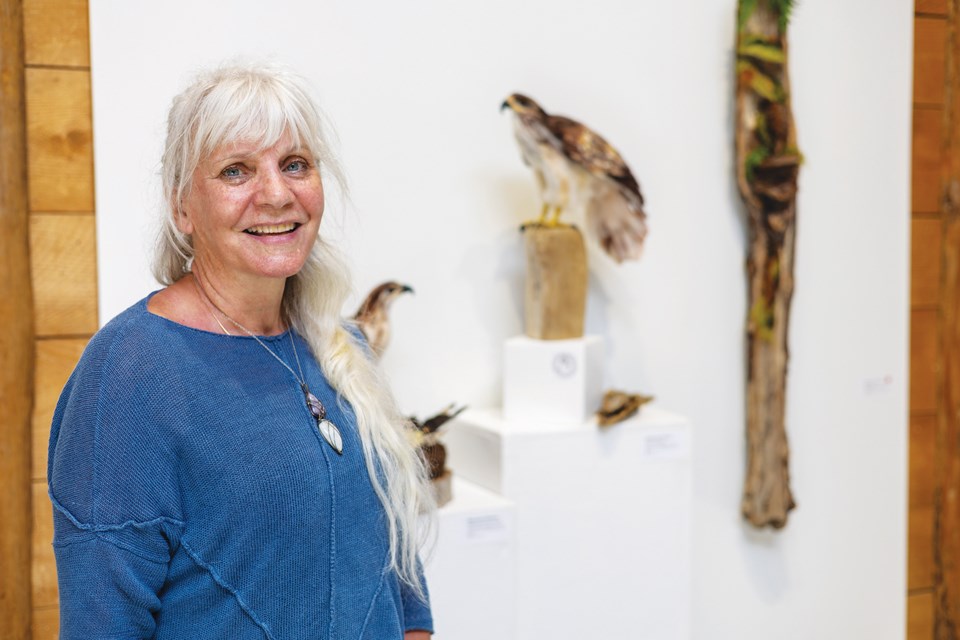The creatures depicted in artist Marianne Hansen’s debut solo exhibition Birds of Prey may be high flyers — majestic, strong, sagacious — but Hansen applies her skill with wire armatures and mixed fibres to keep her flock tethered to a more pragmatic plane.
Birds of Prey opened at the Sunshine Coast Arts Centre on June 28 with a crowded public reception for the Sunshine Coast-based artist.
In her sculpture Bald Eagle Courtship, she used merino wool, plant fibres and silk to depict the birds engrossed in a mid-air tête-à-tête, linked by talons formed from wax. In Fishing Osprey, a salmon falls victim to the deft raptor, which grips its hapless hors d’oeuvre with vast wings outstretched. Despite the birds’ seraphic form and musculature, the message is clear: nature is ever red in tooth and claw.
“I tried to be [somewhat] elusive,” said Hansen. “Of course I showed the fish in the osprey, but most people can deal with that and there are no droplets of blood or whatever. I could have had a mouse in the barn owl’s talons, but I really felt that people might be put off by that, so I made them separately. And of course, I’m not sure if I could cope, myself, with trying to make a great horned owl eating a hare.”
Instead, the tawny hare is shown mid-leap, its hind legs airborne in flight from an airborne attacker. In Chanterelle Mouse, the rodent gazes warily at the sky, resting its paws on the mushroom cap.
Hansen — a lifelong handcrafter — began her intensive study of textile sculpture just two years ago. “It was a huge learning curve,” she said, “but I’d been searching for an art form that really spoke to me and I just feel I have an affinity with birds. This art form is something that I felt like I could really work in.”
Earlier this year Hansen displayed a selection of her work at the Ferry Building Gallery in West Vancouver, alongside art by painters Ralph Sears and Stephanie Taylor.
Her fascination with the avian world started early: in her youth, Hansen raised large parrots from birth. At home on the Coast, she spends her mornings watching bald eagles perched on a breakwater, poised to feed.
Last year, she observed a great horned owlet that had been knocked from its nest by ravens. “He wasn’t fully-fledged,” Hansen recalled, “and he was on the ground, and people were more interested in the photo op than in the condition of the animal. He was in the sun; he couldn’t fly; he was frightened.” She secured the owlet in a cat carrier and brought him to the (now-closed) Gibsons Wildlife Rehabilitation Centre. It was later transferred to an owl rescue centre in the Lower Mainland.
“It’s important to bring a level of awareness of the animals that we live with, and what we can do to be good neighbours,” said Hansen. “We’ve encroached on their territory and perhaps it would be motivating for people if they could understand when birds are in distress and what measures to take.”
Hansen works from reference photographs that she takes herself, and images collected from the Internet. She determines the size of component parts — tails, beaks, and wings — and extrapolates the necessary dimensions of the sculpture’s wire armature. The pictures guide a colour-blending process as complex as any painter’s palette: “It’s not just one colour of brown that you buy in order to create depth and make it more realistic,” she said. “I use different colours of wool to make the colour that closely represents what it is in real life.”
The show’s dozens of woodland denizens — which took three months of concentrated, “hermit-like” efforts to finalize, according to Hansen — also includes depictions of habitat. Mounted just a metre from a spindly perch for a wren, sparrow, chickadee and robin, Mossy Wood combines merino wool, silk and driftwood, adding verdant verisimilitude to the three-dimensional bestiary.
“I didn’t want to go back into crafting, becoming a production machine, making the same thing over and over again,” Hansen said. “In this art form, I might do another peregrine falcon, but it will never be the same again.”
Marianne Hansen’s Birds of Prey remains on display at Sechelt’s Sunshine Coast Arts Centre until Aug. 17.



